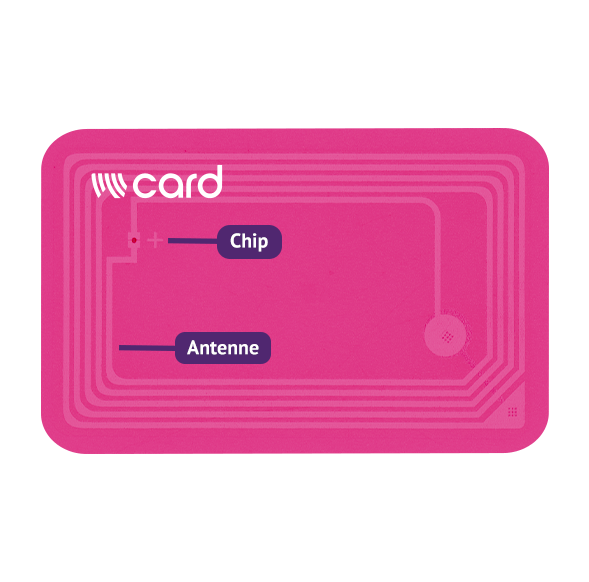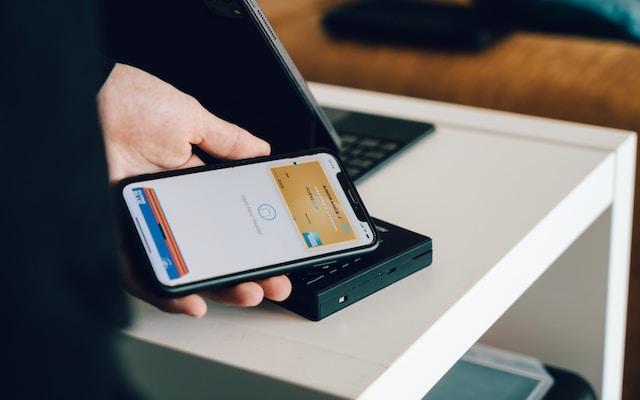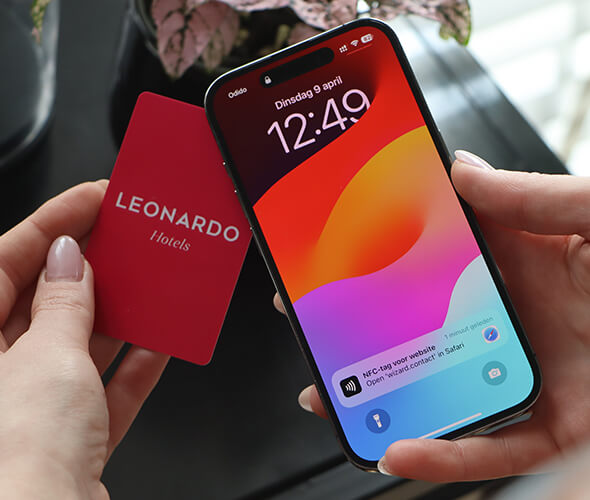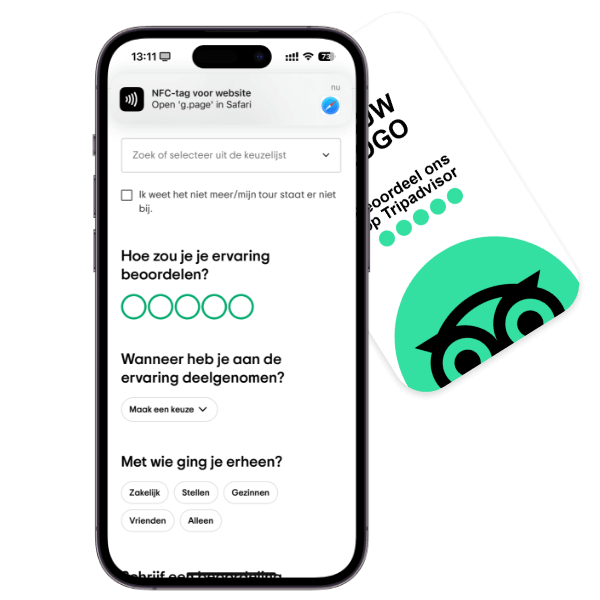Chances are you already own a phone or another device that supports NFC. But what exactly is NFC? It stands for Near Field Communication. Simply put, it’s a technology for wireless data transfer that doesn’t require an internet connection — similar to Bluetooth. The main difference is that NFC works over a much shorter range.
While that might sound like a downside, this short range is actually a major benefit for many applications. NFC is incredibly easy to use, fast, and fully automatic. It’s no surprise that NFC technology is being used in more and more everyday situations — such as contactless payments with your mobile phone or travel cards.
Besides smartphones, you’ll also find NFC in tablets, speakers, game consoles, card readers, and now even in a modern NFC business card.
How Does NFC Work?
NFC is not a new technology. It’s an evolution of RFID (Radio-Frequency Identification), which has been around for decades — for example, in hotel key cards used to open doors. The main difference between these two wireless technologies lies in their transmission range. While RFID can reach up to 50 metres, NFC operates within just a few centimetres.
The key advantage of NFC is that no manual pairing between devices is required. An NFC connection is established completely automatically when another NFC chip enters its range. Once the devices are within range and the NFC link is made, small amounts of data can be exchanged. Thanks to the speed of NFC technology, this data transfer is completed within just a few seconds.
How Is an NFC Chip Constructed?
An NFC chip is made up of several components, including an antenna, memory, and a microcontroller. The antenna receives the NFC signal and sends it to the microcontroller, which processes the information and stores it in the chip’s memory. When the chip is scanned, this information is transmitted back via the antenna.
There are different types of NFC chips, each with specific specifications and functionalities, depending on their intended use.

iPhones
Apple has supported NFC on iPhones since the iPhone 6. To use NFC, simply hold your iPhone close to an NFC tag. Newer iPhone models, such as the iPhone XS and later, support background NFC reading — meaning you don’t need to open any additional apps to scan NFC tags.
Android
Most modern Android devices support NFC. To use it, make sure the NFC feature is enabled in your phone’s settings. Then simply hold your device close to an NFC tag to exchange data.
Which Devices Have NFC?
The possibilities with NFC are endless, but it’s most commonly used in mobile phones. NFC has been on the rise in smartphones for several years now. Occasionally, it may be omitted from very low-budget models, but in general, most modern smartphones are equipped with an NFC chip.
In addition to mobile applications, NFC is also used in credit cards, hotel key cards, smart locks, tablets, laptops, smartwatches, business cards, and much more.

What Is NFC Used For?
NFC, or Near Field Communication, is being used in more and more applications. It’s mainly used for contactless communication between devices over very short distances. You’ll find it in mobile phones, debit cards, credit cards, smartwatches, and gaming devices.
Business Cards
An NFC business card offers many advantages. You only need one card, saving a significant amount of paper each year. This is not only better for the environment, but also for your wallet. The card links to your digital business card, where all your contact details are stored. This allows the recipient to download and save your information to their contacts in just a few seconds.
In addition, an NFC business card offers many more benefits. The digital card can be updated easily without needing to print a new one. For example, if your job title changes or you get a new phone number, you can easily update your details in your digital profile. This ensures your contact information is always up to date.

NFC Google Review Cards
NFC Google Review Cards are an innovative way to quickly and easily ask customers to leave a review. These cards are equipped with an NFC chip and a QR code. Customers can simply tap their phone on the card or scan the QR code to be taken directly to your Google Review page. This increases the likelihood of receiving positive reviews and helps boost your online reputation.

NFC Tripadvisor Review Cards
Just like Google Review Cards, NFC Tripadvisor Review Cards offer a convenient way for customers to leave a review quickly. After visiting a restaurant, hotel, or attraction, customers can simply tap their phone on the card or scan the QR code to go straight to your Tripadvisor review page. This makes it easier for them to share their experience and helps you collect more positive reviews on Tripadvisor.

Mobile Phones
NFC in mobile phones is most commonly used for contactless payments. These are linked to your bank account or to services like Google Pay, Apple Pay, or Samsung Pay. Some credit card providers also offer their own mobile app, allowing you to link your credit card and make NFC payments directly.
Bank Cards, Credit Cards and Other Smart Cards
An NFC chip can be embedded in a card, enabling you to make contactless payments with your debit or credit card using a simple ‘tap’ on the payment terminal. There’s no need to insert the card into the machine anymore. NFC is also used in other cards such as hotel room keys or public transport cards. Hotel key cards function as digital keys and can be activated or deactivated easily. With transport cards, your balance is deducted and your journey registered automatically.
Smartwatches
Near Field Communication technology has now fully made its way into smartwatches, allowing users to make payments directly from their wrist. For example, the Apple Watch is equipped with such a tag.
Wireless Headsets or Speakers
Devices without screens can be paired easily with other devices using NFC. NFC handles the initial quick pairing, after which the connection is taken over by Bluetooth or Wi-Fi.
Gaming
In gaming, NFC is used to connect additional accessories to a console. For example, you can physically buy a new character or accessory to use as a toy, and also implement it in the game via NFC.
How Secure Is NFC?
NFC is a secure technology because it only works over very short distances, making it difficult for hackers to eavesdrop or intercept the communication. In addition, NFC uses strong encryption to protect the data being transferred. For applications such as contactless payments, extra layers of security are also added to ensure that your financial information remains safe.
Veel gestelde vragen
NFC stands for Near Field Communication. It is a wireless technology that allows devices to communicate with each other over short distances.
No, NFC is not the same as Bluetooth. NFC is designed for exchanging small amounts of information over short distances, whereas Bluetooth is a wireless technology used for transferring larger amounts of data over longer distances.
Yes, most modern smartphones come with a built-in NFC chip.
Yes, NFC is safe because communication between devices only occurs when they are very close to each other — usually less than 10 centimetres apart.
NFC tags are small tags that can be added to products compatible with NFC technology. They are capable of storing a limited amount of data. An NFC tag consists of three basic components: the chip, the (usually copper) antenna, and the adhesive material. The adhesive is often in the form of a sticker that holds the chip and antenna together.
The NFC sticker is not the only form — the tag can also be produced as a type of token or disc. The chip provides the storage, while the antenna enables wireless communication within range.
No, an NFC chip cannot run out. NFC chips are passive, meaning they don’t have their own power source. Instead, they draw the energy they need from the magnetic field generated by the device that reads the chip, such as a smartphone or payment terminal. As long as the reading device has power, it can continue to read the NFC chip. So there’s no risk of an NFC chip “running out”.
There is no limit to the number of scans an NFC chip can handle. NFC chips don’t require a battery or any other power source, which means they can be scanned an unlimited number of times without wearing out or running out. This makes NFC a durable and cost-effective technology for applications like digital business cards, payments, and more.
